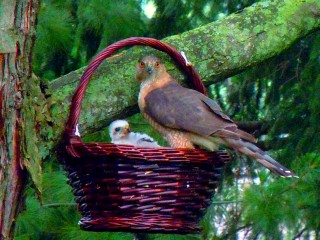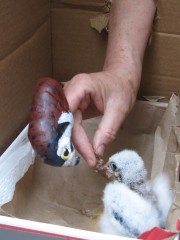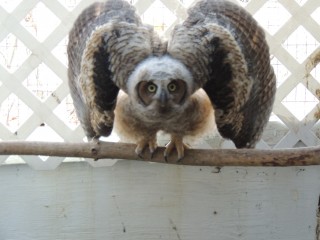
The nestling Cooper’s Hawk was found on the ground, and could not be placed back in the original nest. A secondary nest was hung nearby, and the parent birds successfully raised the young from both nests.
Orphans and specialized care
There are times when nestling hawks or owls are truly orphaned. Parent birds are sometimes struck by cars or are confronted with disruptions that cause them to abandon their nest. In this case, the young bird may need to be cared for in a rehabilitation setting.
More often than not, young birds that are picked up by well-meaning individuals, and don’t really need human intervention. If there is a need for human intervention, it can sometimes be minimal; with a little help, the parent birds may be able to continue their care of the young.
When a nestling bird is accepted in for rehabilitation, we first determine if the parents are still active in the vicinity of the nest. The nestling can sometimes be placed back in the original nest, or in a nearby nest box or artificial nest. This can be a very successful situation; parent birds can often continue caring for their youngsters themselves.
If a young hawk or owl is truly orphaned, it must be cared for with the use of a puppet of that species, or by a foster parent of the same species, or a combination of both. If done properly, the young bird is raised in a very natural setting, and learns all the behaviors, vocalizations, and hunting skills that are needed in order to fit into its habitat and survive as a wild bird.

This nestling American Kestrel was taken in because of a nest disruption. The puppet mother was used to initially care for the youngster until we could be sure he was healthy and strong. Later, he was introduced to a live American Kestrel foster parent. both adult and youngster bonded quickly.

This juvenile great horned owl is displaying defense posture, a behavior that needs to be retained during rehabilitation if the owl is to be released. Habituation to people will destroy this tendency to posture.